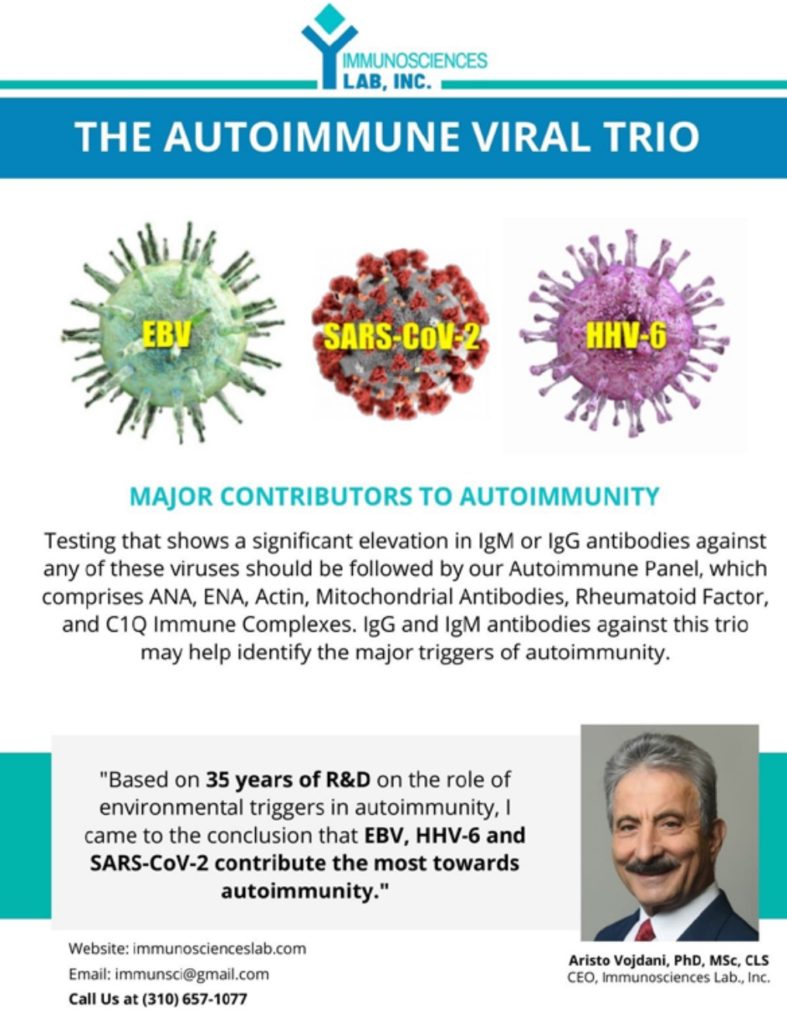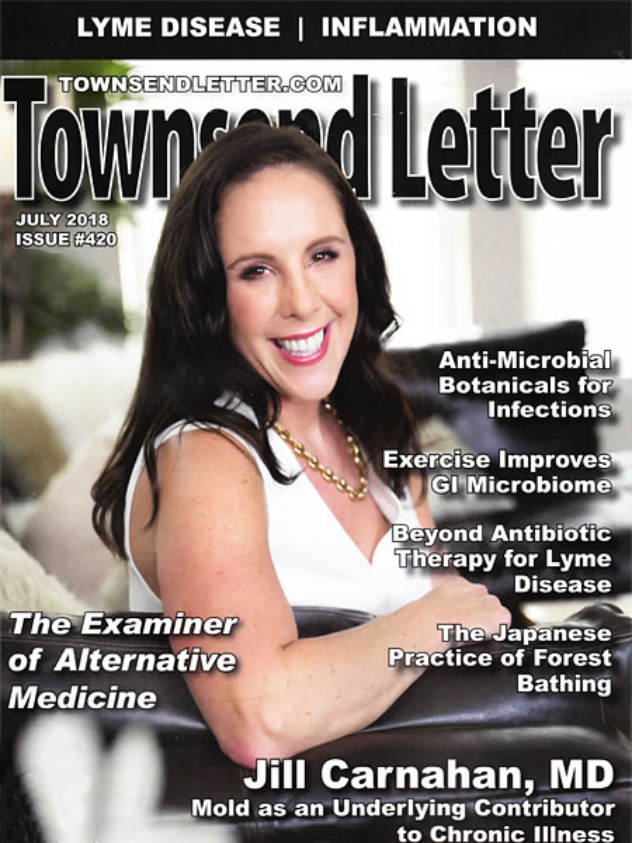Chronic and complex illnesses are inherently complex and difficult to treat for doctors operating under the modern healthcare system. These illnesses require more thorough medical histories, testing, treatment plans, and patience than many conventional doctors are able to provide due to time, money, and insurance constraints.
Developments in treating complex chronic illnesses are in a constant state of flux as we learn more about infectious and toxic triggers. Thus, doctors choosing to treat patients with chronic conditions must forever be students. Educating ourselves on the most current medical literature and protocols is essential for the success of future treatments.
There is no doubt in my mind that this shift from treating symptoms to treating root cause of infectious and environmentally acquired illnesses will only continue to grow. In my personal practice, I’m seeing a rise in conditions such as:
- Chronic inflammatory response syndrome (CIRS),
- Neuroinflammatory conditions,
- Mast cell activation syndrome (MCAS),
- Tick-borne illnesses,
- Viral reactivation and viral load illnesses, and
- All autoimmune diseases.
Moreover, I continue to hear similar patterns from my colleagues. It’s not that environmentally acquired illnesses are new, it’s that our industrial society is rapidly contributing to the overall toxic burden of the body through new chemicals, plastics, artificial ingredients in the food supply, and cheap construction materials that foster an ideal breeding ground for mold. I often think in terms of total toxic load and infectious burden. Most of these chronic conditions are a complex stew of both of these things.

The model of care required to successfully treat illnesses like chronic inflammatory response syndrome provides integrative and functional medicine practitioners with a unique opportunity to fill a much-needed gap in today’s world of medicine.
Specifically, mold-related illnesses have become of particular concern because – depending on the mold species, a person’s genetic predisposition, and level of mold exposure – mycotoxins and the other inflammagens and toxins present in a water-damaged building can result in many types of inflammatory responses, including the following:1,2
- Chronic inflammatory response syndrome (CIRS),
- Mycotic infections (mycoses),
- Fungal rhinosinusitis,
- Asthma,
- Pulmonary diseases like hypersensitivity pneumonitis and VOC-induced COPD,
- Mitochondrial toxicity,
- Cytotoxicity/cancer,
- IgE-mediated sensitivity,
- Hypersensitivity pneumonia,
- Carcinogenicity,
- Nephrotoxicity,
- Immune system suppression/dysfunction,
- Abnormalities in T and B cells,
- Central and peripheral neuropathy, and
- Sarcoidosis.
More and more, we are finding how significantly environmental factors can influence disease states. Although, it’s not just the environment that plays a role; each person brings their own set of genetics and other variables to the table.![]()
Mycotoxin Mechanisms of Injury
The ways in which mycotoxins impact the body differ greatly based on the person, the mycotoxin, and any other exposures that may be occurring. Here’s a brief overview of the different mechanisms of injury from mycotoxins3:
- Infections,
- Allergies,
- Inflammation,
- Autoimmunity,
- Oxidative stress,
- Toxicity,
- Carcinogenicity,
- Synergistic interactions with other bio-contaminants; water-damaged buildings (WDB) nearly always have more than just mycotoxins causing issues (endotoxins, beta glucans, dust, VOCs, etc.).

“The Townsend Letter provides a platform for those examining and reporting on functional and integrative medicine. Please support these Independent Voices!”
What Does a Patient Who Has Been Exposed to Mold Look Like?
No two mold patients look exactly the same, which is why case studies are one of the best methods for learning more about mold-related illnesses. (See Case Study, above)
 That being said, there are some common symptoms:
That being said, there are some common symptoms:
- Extreme fatigue,
- Weakness,
- Headaches,
- Light sensitivity,
- Brain fog,
- Insomnia,
- Morning stiffness and joint pain,
- Tingling or numbness,
- Shortness of breath,
- Chronic cough or sinus congestion,
- Sugar cravings,
- Metallic taste in mouth,
- Vertigo,
- Static shocks,
- Digestive issues – gas, bloating, heartburn, diarrhea or constipation,
- Blurred vision or red eyes,
- Balance issues,
- Anxiety,
- Depression,
- Skin rashes,
- Urinary incontinence,
- Decrease libido,
- Frequent infections, and
- Chemical intolerance or MCS.
Other common presentations include the following3:
- Seeking multiple practitioners and feel desperate and hopeless,
- Having tried many different treatments with little success,
- Taking multiple medications or intolerance to most medications,
- Normal routine lab work,
- Well appearance, and
- Having been diagnosed with any of the following: chronic fatigue syndrome (ME/CFS), fibromyalgia, depression/anxiety, non-specific rheumatologic disorders, asthma, chronic allergic rhinitis, interstitial cystitis, irritable bowel syndrome, gastroesophageal reflux disease, and/or chemical sensitivity.
Common Misconceptions About Mold Patients
 Due to the complex nature of mycotoxin illness, many misconceptions have arisen. It’s important not to assume any of the following about a patient is true(3:
Due to the complex nature of mycotoxin illness, many misconceptions have arisen. It’s important not to assume any of the following about a patient is true(3:
- They must have the HLA susceptible gene to become sick.
- If others in their home or work aren’t sick, it can’t be mold.
- If their labs are normal, it can’t be mold-related illness.
- If they moved and symptoms didn’t get better, it can’t be mold.
- They don’t look sick, so it can’t be mold.
- They have multisystem symptoms, and therefore it can’t be mold.
Factors That Affect How Mold-Related Illness Presents in the Body
How mycotoxins affect an individual depends on hundreds of factors, which is part of the reason definitive diagnostics remain complex. Factors that influence how mycotoxin exposure presents include the following:
- Nutrient deficiency (which could be due to either diet or poor absorption),
- Other microbial infections,
- Alcohol and drug use,
- Other autoimmune or degenerative diseases,
- Genetics – particularly HLA DR typing and MTHFR; and
- Method of exposure: Inhalation and ingestion are most common. Surprisingly inhalation may be many times more toxic than ingestion. However, transdermal should not be ruled out.4 Those who work in agriculture and some industrial occupations could have a higher risk of exposure.3
How Should a Clinician Approach the Patient with Suspected Mold-Related Illness?5
• Ask about the above symptoms. Create a handy ROS sheet that pertains to water-damaged buildings (WDB) and mold-related illness.
• Take a comprehensive medical history including birth and in utero exposure.
• Some common questions…
- Has your work or home recently been flooded or had water damage?
- Have you noticed mold in your work or home?
- Are any of your family members or coworkers chronically sick or experiencing similar symptoms to you?
- Do your symptoms get worse on rainy days?
- What do you do for work?
- What are your hobbies? Looking for other areas of exposure.
- Are you exposed to dust, chemicals, or fumes at work?
- Do your symptoms change when you’re in a particular location? (Keep in mind, sometimes when a person is ill due to mold exposure they increasingly stay at home, which worsens their condition if that’s the source.)
- Be sure to rule out other conditions.
Additionally, you can have them take the Visual Contrast Sensitivity test.6 This test can be taken at home, costs $15 online or can be done in office. It checks their ability to distinguish between very similar shades of black and gray. The inability to differentiate between slight color variations is a sign of neuroinflammation that can be caused by mycotoxins and other biotoxins. You can order a full panel of urinary mycotoxins through Real Time Labs or Great Plains Labs to document exposure to mycotoxins. I frequently order inflammatory markers on routine lab work as well as including, HLA typing, C3a, C4a, VEGF, MMP-9, MSH, PA-1 activity, TGF-beta, VIP, ADH/Osm, APA, ACA, Leptin/adiponectin, amylase/lipase, Ig levels and subclasses, ANA, and other viral and atypical bacterial infectious titers.
How Prevalent Are Moldy Buildings?
We now spend 90 percent of our time indoors, which adds to the impact indoor air pollution can have on our health.7 Molds can grow in a variety of climates and only need 24 to 28 hours of dampness to start growing.8 Estimates vary on how many homes have mold growth; however, overall, they suggest moldy buildings are more prevalent than many realize.
These reports are a few of the studies that have led to the widespread and common claim that about half of all American homes have dampness and mold growth.

Though, this potentially high prevalence of mold growth across the country is a definite reason for concern, there’s a lot of good news that comes with environmentally acquired illness. First and foremost, is the ability to remove a patient from the environment or implement remediation to improve their overall health. Diagnosis, treatment, and prognosis of mold-related illnesses have a positive potential outcome once the origin of the assault is identified and removed.
This is where awareness and education come in. As a country, we are in denial at how significant the role mold and mycotoxins play in our health, and it’s time we all paid better attention.
Mold in Our Food
Another major source of mold is our food supply. Most of the studies on mycotoxins in the food supply revolve around animal feed. Overall, we could use more investigation on mycotoxins in our food, though the United Nations estimates that about 25 percent of the world’s food supply is impacted by mycotoxins – primarily grains, corn, and anything that is stored for long periods of time.14 Research has found that most acute mycotoxicosis cases have occurred due to mycotoxins in the food supply.15
Dr. Jill’s Low-Mold Diet
Foods That Must Be Avoided
Avoid sugar and sugar-containing foods: table sugar and all other simple, fast-releasing sugars such as fructose, lactose, maltose, glucose, mannitol and sorbitol. This includes honey and natural sugar syrup type products such as maple syrup and molasses. This also includes all candies, sweets, cakes, cookies, and baked goods. Sweetleaf whole leaf stevia concentrate may be used in moderation.
High sugar fruits:
- Avoid pineapple, mango, banana, melons, oranges, and grapes.
- Organic berries, apples and lemon/lime are okay.
Packaged and processed foods:
- Avoid canned, bottled, boxed, and otherwise processed and pre-packaged foods as they more often than not contain sugar of one type or another.
- Canned – Baked beans, soups, ready-made sauces.
- Bottled – Soft drinks, fruit juices, all condiments and sauces.
- Boxed/Packaged – Ready-made meals, breakfast cereals, chocolate/candy, ice cream, frozen foods.
Mold- and yeast-containing foods:
- Cheeses: All cheese, especially moldy cheeses like Stilton are the worst, buttermilk, sour cream, and sour milk products.
- Alcoholic drinks: beer, wine, cider, whiskey, brandy, gin, and rum.
- Condiments: vinegar and foods containing vinegar, mayonnaise, pickles, soy sauce, mustard, relishes.
- Edible fungi, including all types of mushrooms and truffles.
- Processed and smoked meats: sausages, hot dogs, corned beef, pastrami, smoked fish, ham, bacon.
- Fruit juices: All packaged fruit juices may potentially contain molds.
- Dried fruits: raisins, apricots, prunes, figs, dates, etc.
Foods Okay to Be Eaten in Small Amounts:
- Gluten-free grains: brown rice, quinoa, buckwheat, millet, teff, certified gluten-free oats
- High starch vegetables and legumes: sweet corn, potatoes, beans and peas, lentils, sweet potatoes, squashes, turnips, parsnips.
- Fruits: low sugar types such as berries, apples, pears and peaches.
Foods to Be Eaten Freely:
- Organic pastured animal products: beef, bison, veal, lamb, buffalo, wild-caught seafood, poultry, pastured eggs.
- Low-carbohydrate vegetables: broccoli, spinach, cauliflower, kale, cabbage, arugula, chard, cucumber, peppers, tomato (fresh only), onion, leek, asparagus, garlic, artichokes.
- Raw nuts and seeds: sunflower seeds, pumpkin seeds, flax seeds, chia seeds, almonds, low-mold nuts. (No peanuts, walnuts, pecans, cashews, Brazil nuts)
- Healthy Fats: extra virgin olive oil, coconut oil, coconut milk, ghee, avocado, organic butter.
- Other: tempeh, miso, apple cider vinegar
- Beverages: filtered water, non-fruity herbal teas, mineral water, fresh veggie juice.
Mycotoxins of Concern
The Centers for Disease Control and Prevention (CDC) estimates there are over 500 species of hazardous molds; though, in the past decade or so a few have begun to stand out among the rest.16
- Aflatoxins,
- Aflatrem (a tremorgenic mycotoxin),
- Aspergillosis,
- Citreoviridin,
- Ergot alkaloids,
- Fumonisin B1,
- Gliotoxin,
- Macrocyclic trichothecenes,
- Ochratoxin A,
- Patulin,
- Penitrem,
- Rubratoxin,
- T-2 Toxin,
- Tremorgens,
- Verruculogen, and
- Zearalenone.
Of these mycotoxins, the most dangerous and best studied thus far include the following mycotoxins.
Aflatoxins (AT) – Aflatoxins are natural carcinogens and commonly contaminate foods, especially crops that are pre-harvested and stored, such as grains, corn, nuts, and seeds. Aflatoxins can also be found in water-damaged or damp buildings where Aspergillus mold is growing. Aflatoxins can cause many different forms of aspergillosis, which is a group of diseases caused by mycotoxins of the Aspergillus genus.
Aflatoxins are fat soluble and readily absorbed by the body. They are usually ingested through contaminated foods or inhaled through dust particles of food items. Once in the bloodstream they are distributed to tissues and the liver. From here (depending on the type of aflatoxin) they are metabolized into different proteins that can cause DNA damage and induce cancer or acute toxicity (aflatoxicosis).17
Aflatoxin exposure can result in leukemia, lymphoma, aplastic anemia, and renal failure. This mycotoxin gravely impacts the central nervous system through an invasion of blood vessels causing hemorrhagic infarction.18
Aflatrem – Aflatrem is a secondary metabolite of Aspergillus flavus that commonly occurs alongside aflatoxins. This fungus is commonly found in corn and therefore ends up in cattle feed. Aflatrem is able to infect both livestock and humans, where it has profound neurotoxic effects. Aflatrem decreases the capacity of glutamate and GABA uptake, which translates as degradation of nerve terminals, a decrease in corresponding neurotransmitters, and their release.19 This mycotoxin can result in seizures, tremors, and disorientation.
Fumonisin B1 – Another mycotoxin mostly found in corn and cereals, Fumonisin B1 induces neuronal degeneration in the cerebral cortex, disrupts sphingolipid synthesis, inhibits protein synthesis, promotes DNA fragmentation, increases lipid oxidation, causes cell death, and can eventually result in death.20,21
Macrocyclic trichothecenes (MT) – Macrocyclic trichothecenes of Stachybotrys chartarum, is one of the mycotoxins most often found in water-damaged buildings. MT is commonly found in ventilation systems, drywall, and ceiling tiles, but unlike many other mycotoxins, it’s also found in airborne particles.22
 MT causes neuronal cell apoptosis and inflammation in the olfactory epithelium and olfactory bulb.21 It inhibits protein synthesis through binding to proteins and other macromolecules. Chronic exposure to MT causes inflammation and cell death, which can lead to respiratory illness, immune system dysfunction, CIRS, and neurological impairment.23
MT causes neuronal cell apoptosis and inflammation in the olfactory epithelium and olfactory bulb.21 It inhibits protein synthesis through binding to proteins and other macromolecules. Chronic exposure to MT causes inflammation and cell death, which can lead to respiratory illness, immune system dysfunction, CIRS, and neurological impairment.23
Ochratoxin A (OTA) – OTA is caused by several species of mold and found both in food and water-damaged buildings. This mycotoxin is neurotoxic, teratogenic, immunotoxic, and genotoxic. OTA impacts the body by causing oxidative stress, which impairs the mitochondria, and inhibits protein synthesis. Chronic exposure to OTA has been associated with kidney diseases and enzymuria.24
In a 2013 study on CIRS, 93 percent of the 112 patients tested positive for one of three mycotoxins AT, MT, and OTA. Additionally, 30 percent tested positive for more than one mycotoxin. Of the three mycotoxins tested, OTA was by far the most common, accounting for 83 percent of all cases.25
T-2 Toxin – T-2 Toxin is not usually associated with chronic conditions but still worth mentioning because low level exposures to certain mycotoxins are proving to cause complex conditions, meaning, the T-2 toxin shouldn’t be disregarded.
T-2 Toxin commonly causes an acute mycotoxicosis reaction and is usually found in contaminated foods. T-2 toxin causes neuronal cell apoptosis in fetal and adult brains.21 It inhibits protein synthesis through binding to peptidyl transferase, which triggers a ribotoxic stress response.266 T-2 toxin also interferes with membrane phospholipid metabolism, increases liver lipid peroxides, and suppresses glutathione S-transferases.
Psychological Effects of Mycotoxins

Perhaps the most startling findings surrounding the effects of mold on human health is the widespread and debilitating psychological, neurotoxic, and electrocortical impacts. Patients who are exposed to mold mycotoxins typically experience strong cognitive and emotional symptoms.
I often see depression, anxiety, and signs of strong PTSD-like reactions in my patients with mold exposure. Sometimes their symptoms appear similar to a mild brain injury. This is due to a hypoactivation of the frontal cortex, constant activation of inflammatory and apoptotic pathways at low levels of exposure in brain capillary endothelial cells, neuronal damage, and inflammation. Cognitive impairment, inability to multitask, and mood swings are also common.27,28 Studies even suggest that low level exposure to OTA increases oxidative DNA damage and decreases striatal dopamine levels, which could lead to symptoms of parkinsonism.29
One of the most fascinating developments unfolding in the realm of mold-related illness is the research under Dr. Dale Bredesen of the Buck Institute for Research on Aging. Dr. Bredesen has identified six subtypes of Alzheimer’s disease, one of which is called Inhalational Alzheimer’s Disease (IAD). He attributes the pathogenesis of this subtype to biotoxins, such as mycotoxins.
Inhalational Alzheimer’s disease is a phenotypic manifestation of CIRS. The onset of IAD typically occurs at a younger age, the ApoE genotype is typically 3/3 instead of 4/4 or 3/4, there’s usually a lack of family history of Alzheimer’s, the symptoms are often set off by a period of stress, anesthesia, loss of sleep, menopause or andropause. Instead of memory loss, cognitive symptoms typically include depression, dyscalculia, executive dysfunction, aphasia, or other cortical deficits.30
Beyond Mold – This is Just the Beginning
Though there is still much to understand about mold and mycotoxins exposure, they are actually one of the best understood indoor air contaminants. Beyond mycotoxins, other exposures we know far less about include Gram negative and positive bacteria, endotoxins, microbial particulates, non-microbial volatile organic compounds, glucans, and microbial volatile organic compounds. All in all, we are just breaking ground in our understanding of environmentally acquired illness.22,31
There’s a need and demand for more doctors on the front lines of environmentally acquired illnesses. I believe our understanding of mold-related illnesses is in its infancy. As we continue to research and understand the effects of mycotoxins (and other pathogens) on human health, we will be more effective in our diagnosis and treatment of mold-related illness. And I, for one, am committed to leading the way.
Dr. Jill Carnahan completed her residency at the University of Illinois Program in Family Medicine at Methodist Medical Center. In 2006 she was voted by faculty to receive the Resident Teacher of the Year award and elected to Central Illinois 40 Leaders Under 40. She received her medical degree from Loyola University Stritch School of Medicine in Chicago and her Bachelor of Science degree in bio-engineering at the University of Illinois in Champaign-Urbana. She is dually board-certified in family medicine (ABFM) and integrative holistic medicine (ABIHM).
Dr. Jill was also part of the first 100+ health-care practitioners to be certified in functional medicine through the Institute of Functional Medicine (IFMCP). In 2008, Dr. Carnahan’s vision for health and healing resulted in the creation of Methodist Center for Integrative Medicine in Peoria, IL, where she served as the medical director for two years. In 2010, she founded Flatiron Functional Medicine in Boulder, Colorado, where she partnered in functional medicine with medical partner, Dr. Robert Rountree. She recently opened a brand new medical clinic with a broad range of services in Louisville, Colorado.
Dr. Jill is also a 15-year survivor of breast cancer and Crohn’s disease and passionate about teaching patients how to “live well” and thrive in the midst of complex and chronic illness. She is also committed to teaching other physicians how to address underlying cause of illness rather than just treating symptoms, through the principles of functional medicine. She is a prolific writer, speaker, and loves to infuse others with her passion for health and healing!
References
1. Campbell AW, et al. Mold and mycotoxins: effects on the neurological and immune systems in humans. Adv Appl Microbiol. 2004;55:375.
2. Brewer JH, Thrasher JD, Hooper D. Chronic illness associated with mold and mycotoxins: is naso-sinus fungal biofilm the culprit? Toxins. 2014;6(1):66-80.
3. Hope, Janette. Complete evaluation of mold exposed patients and their environments. Lecture presented: AAEM Dallas 2018.
4. Boonen J, et al. Human skin penetration of selected model mycotoxins. Toxicology. 2012;301(1-3):21-32.
5. Storey E, et al. Guidance for clinicians on the recognition and management of health effects related to mold exposure and moisture indoors. University of Connecticut Health Center. 2004.
6. Visual Contrast Sensitivity Test. VCSTest.com website. https://www.vcstest.com/ Accessed February 2018.

7. US Environmental Protection Agency. 1989. Report to Congress on indoor air quality: Volume II – Assessment and Control of Indoor Air Pollution. Washington, DC. EPA Office of Air and Radiation; 1989. EPA/400/1-89/001C. https://nepis.epa.gov/Exe/ZyPURL.cgi?Dockey=9100LMBU.TXT. Accessed February 2018.
8. Federal Emergency Management Agency. Dealing With Mold & Mildew in Your Flood Damaged Home. https://www.fema.gov/pdf/rebuild/recover/fema_mold_brochure_english.pdf. Accessed February, 2018.
9. Brunekreef B, et al. Home dampness and respiratory morbidity in children. Am Rev Respir Dis, 1989;140(5): 1363-7
10. Maier, WC, et al. Indoor risk factors for asthma and wheezing among Seattle school children. Environ Health Perspect, 1997;105(2): 208-14.
11. Spengler J, et al. Respiratory symptoms and housing characteristics. Indoor Air, 1994;4:72-82.
12. Stark PC, et al. Fungal levels in the home and lower respiratory tract illnesses in the first year of life. Am J Respir Crit Care Med. 2003;168(2): 232-7.
13. Prevalence of Building Dampness. Lawrence Berkeley National Laboratory Indoor Environment Group website. https://iaqscience.lbl.gov/dampness-prevalence. Accessed February 2018.
14. United States Department of Agriculture. Molds on Food: Are They Dangerous? Food Safety and Inspection Service; 2013.
15. Bennett JW, Klich M. Mycotoxins. Clin Microbiol Rev. 2003;16(3): 497-516.
16. Brandt ME, Lockhart SR, Warnock DW. Laboratory aspects of medical mycology. In: Kauffman C, Pappas P, Sobel J, Dismukes W, (eds). Essentials of Clinical Mycology. New York: Springer; 2003:1–22.
17. Bbosa GS, Kitya D, Lubega A, et al. Review of the Biological and Health Effects of Aflatoxins on Body Organs and Body Systems, Aflatoxins – Recent Advances and Future Prospects. 2013.
18. Walsh TJ, Hier DB, Caplan LR. Aspergillosis of the central nervous system: clinicopathological analysis of 17 patients. Ann Neurol. 1985;18(5):574-82.
19. Valdes JJ, Cameron JE, Cole RJ. Aflatrem: a tremorgenic mycotoxin with acute neurotoxic effects. Environ Health Perspect. 1985;62:459-63.
20. Dutton ME. Fumonisins, mycotoxins of increasing importance: their nature and their effects. Pharmacol Ther. 1996;70(2):137-61.
21. Doi K, Uetsuka K. Mechanisms of Mycotoxin-Induced Neurotoxicity through Oxidative Stress-Associated Pathways. International Journal of Molecular Science. 2011; 12(8): 5213–5237
22. Thrasher JD, Crawley S. The biocontaminants and complexity of damp indoor spaces: more than what meets the eyes. Toxicol Ind Health. 2009;25(9-10):583-615.
23. Case Definition: Trichothecene Mycotoxin. Centers for Disease Control and Prevention website. https://emergency.cdc.gov/agent/trichothecene/casedef.asp.
24. Bui-Klimke TR. Wu F. Ochratoxin A and human health risk: a review of the evidence. Crit Rev Food Sci Nutr. 2015; 55(13):1860-9.
25. Brewer JH, Thrasher JD, Straus DC, et al. Detection of mycotoxins in patients with chronic fatigue syndrome. Toxins. 2013;5(4):605-617.

26. Iordonov MS, et al. Ribotoxic stress response: activation of the stress-activated protein kinase JNK1 by inhibitors of the peptidyl transferase reaction and by sequence-specific RNA damage to the alpha-sarcin/ricin loop in the 28S rRNA. Mol Cel Biol. 1997;17(6): 3373-81.
27. Crago BR, et al. Psychological, neuropsychological, and electrocortical effects of mixed mold exposure. Arch Environ Health. 2003;58(8):452-63. 31.
28. Karunasena E, et al. Building-associated neurological damage modeled in human cells: a mechanism of neurotoxic effects by exposure to mycotoxins in the indoor environment. Mycopathologia. 2010;170(6):377-90.
29. Sava V, et al. Can low level exposure to ochratoxin-A cause parkinsonism? J Neurol Sci. 2006;249(1):68-75.
30. Bredesen, DE. Inhalational Alzheimer’s disease: an unrecognized – and treatable – epidemic. Aging. 2016;8(2):304-313.
31.Hope J. A review of the mechanism of injury and treatment approaches for illness resulting from exposure to water-damaged buildings, mold, and mycotoxins. The Scientific World Journal. 2013.






